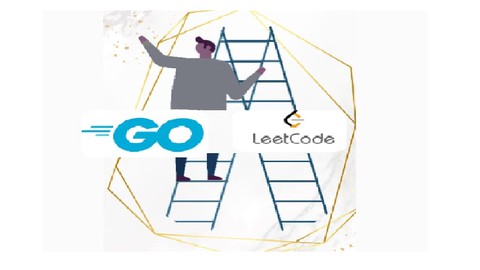
Golang: Interview Bootcamp on DataStructures, LeetCode Algos
Golang: Interview Bootcamp on DataStructures, LeetCode Algos, available at $19.99, has an average rating of 4, with 90 lectures, 8 quizzes, based on 4 reviews, and has 72 subscribers.
You will learn about Ace the Google, Amazon, Meta, Microsoft, Netflix and fortune 500 coding interviews with confidence. Visual walkthrough of the Data structure and Algorithm for quick understanding and fast grasping. Provides ground up level to gain expertise in Data Structures and Algorithms. Improves cognitive thinking capacity and boosts problem solving efficiency. Code with me kind of mode with step by step guidance on most frequently asked interview questions. Provides insights and guidance into Leetcode's must do questions for interview preparation. 11 downloadable source code available. Golang source code included. Understand Big-O notation of algorithms. Improve skills development. Hands-On exercises and solutions on VScode and LeetCode. Step-by-step walkover of the algorithmic workflow and execution on LeetCode. Course delivered by Industry and cloud expert. Live coding implemented so that learners get the picture of complete sequence of application workflows. Helps students learn Golang on the run and ace the interview as well. This course is ideal for individuals who are Developers looking for job in Tier#1 and fortune 500 software companies. or Developers willing to work on Google's Golang environment. or Cloud computing developers willing to write web services. or Professionals who are willing to enhance their career. or Students and university grads willing to upskill with Go coding or University interns and pass out who are curious in learning cloud computing skills. or Learners and students looking for job with Golang skills and cloud arena It is particularly useful for Developers looking for job in Tier#1 and fortune 500 software companies. or Developers willing to work on Google's Golang environment. or Cloud computing developers willing to write web services. or Professionals who are willing to enhance their career. or Students and university grads willing to upskill with Go coding or University interns and pass out who are curious in learning cloud computing skills. or Learners and students looking for job with Golang skills and cloud arena.
Enroll now: Golang: Interview Bootcamp on DataStructures, LeetCode Algos
Summary
Title: Golang: Interview Bootcamp on DataStructures, LeetCode Algos
Price: $19.99
Average Rating: 4
Number of Lectures: 90
Number of Quizzes: 8
Number of Published Lectures: 86
Number of Published Quizzes: 8
Number of Curriculum Items: 98
Number of Published Curriculum Objects: 94
Original Price: $89.99
Quality Status: approved
Status: Live
What You Will Learn
- Ace the Google, Amazon, Meta, Microsoft, Netflix and fortune 500 coding interviews with confidence.
- Visual walkthrough of the Data structure and Algorithm for quick understanding and fast grasping.
- Provides ground up level to gain expertise in Data Structures and Algorithms.
- Improves cognitive thinking capacity and boosts problem solving efficiency.
- Code with me kind of mode with step by step guidance on most frequently asked interview questions.
- Provides insights and guidance into Leetcode's must do questions for interview preparation.
- 11 downloadable source code available. Golang source code included.
- Understand Big-O notation of algorithms.
- Improve skills development.
- Hands-On exercises and solutions on VScode and LeetCode.
- Step-by-step walkover of the algorithmic workflow and execution on LeetCode.
- Course delivered by Industry and cloud expert.
- Live coding implemented so that learners get the picture of complete sequence of application workflows.
- Helps students learn Golang on the run and ace the interview as well.
Who Should Attend
- Developers looking for job in Tier#1 and fortune 500 software companies.
- Developers willing to work on Google's Golang environment.
- Cloud computing developers willing to write web services.
- Professionals who are willing to enhance their career.
- Students and university grads willing to upskill with Go coding
- University interns and pass out who are curious in learning cloud computing skills.
- Learners and students looking for job with Golang skills and cloud arena
Target Audiences
- Developers looking for job in Tier#1 and fortune 500 software companies.
- Developers willing to work on Google's Golang environment.
- Cloud computing developers willing to write web services.
- Professionals who are willing to enhance their career.
- Students and university grads willing to upskill with Go coding
- University interns and pass out who are curious in learning cloud computing skills.
- Learners and students looking for job with Golang skills and cloud arena
Welcome to “Golang: Interview Bootcamp on Data structures, Leetcode Algos” – The First of A Kind , one and only complete Data Structures and Algorithms with Golang on the internet.
This course aims to enable problem solving, approach and cognitive thinking efficiency in learners boost. The approach that I shall dive you across for gaining the same will be by methods discussed below.
Whiteboarding is most best approach adopted by learners to grasp the concept. On the same lines I have demonstrated data structures, algorithms and problems with quick visual walkthroughs. The focus and following features are adopted throughout the course.
-
Visual representation and learning: Helps learners pick up concepts and workflows on complex ideas with flowcharts, diagrams and animations. Pictorial representation also helps memory retention of the concept.
-
Problem solving: Simple breakdown of complex problems into tiny digestible modules are made.
-
Iterative and step-by-step learning: For better refinement and granular grasping of the algorithmic journey, the steps involved are drawn through iterative flows as the instructions on the design flows.
-
Algorithmic designs: Step-by-step walkover into the flow helps understanding of the design and identify potential optimizations as well.
Most of the Tier#1 and fortune 500 software companies prefer to carry out the coding interviews at various levels from freshers through Principal engineers on various coding platforms including but not limited to HackerRank, AlgoExpert, LeetCode, and SPOJ. The course by itself carries more than 65+ Coding exercises some of them carried out as independent code into the VSCode editor with Go compiler. Additionally we will also focus to practice coding via Hands-On exercise using LeetCode.
All of these will make you confident and prepared to walk into a coding interview.
What more can you get ?
I have additionally included the source code for all hands-on exercises as part of downloadable resources. You can download them , save and run them into your environment. This can help you add more features to the code, optimize, debug and learn.
Wide range of topics that we will cover are as follows:
Technical:
-
Big-O notation – impact & purpose.
-
Package Management in GO
-
Design
-
Strings
Data structures:
-
Hash Maps
-
Linked Lists
-
Stacks
-
Queues
-
Binary Trees
It is impossible to gain expertise into any topic discussed here unless you make your hands dirty. So I would suggest that you get started with an editor of your choice and start writing code yourself with me.
What are you waiting for ? Get started and I am excited to take you along this journey of learning Data Structures with LeetCode algorithms using Go !
Course Curriculum
Chapter 1: Introduction
Lecture 1: Introduction to Google's Golang
Lecture 2: Course overview and breakdown
Lecture 3: Applications of Go in Cloud computing world.
Lecture 4: Downloading VScode for Windows
Lecture 5: Installing VScode for Windows
Lecture 6: Course editor for Go programming.
Chapter 2: Big O
Lecture 1: Asymptotic analysis & Big O notation of Algorithms
Lecture 2: Exercise# Computation of Linear complexity | Golang Hands-On
Lecture 3: Exercise# Computation of O(m+n) Linear complexity | Golang Hands-On
Lecture 4: Exercise# Computation of Quadratic complexity | Golang Hands-On
Lecture 5: Exercise# Computation of Cubic complexity | Golang Hands-On
Lecture 6: Exercise# Computation of Constant complexity | Golang Solution | Hands-On
Lecture 7: Exercise# Computation of Complex complexity | Golang Solution | Hands-On
Chapter 3: HashMap by Example
Lecture 1: LeetCode#1832: Check if the Sentence is Pangram | Golang Solution | Hands-On
Lecture 2: LeetCode#242: Valid Anagrams | Golang Solution | Hands-On
Lecture 3: LeetCode#205: Isomorphic Strings | Golang Solution | Hands-On
Lecture 4: LeetCode#771: Jewels and Stones | Golang Solution | Hands-On
Chapter 4: Linked list by Example
Lecture 1: Introduction to Linked list with essential LinkOps | Walkover
Lecture 2: Exercise# Create a simple Singly Linked list | Golang Hands-On
Lecture 3: Exercise# Optimize the Singly Linked list creation | Golang Hands-On
Lecture 4: LeetCode#707 : Design Linked List | Golang solution | Hands-On
Lecture 5: LeetCode#876 : Middle of the Linked List | Golang solution | Hands-On
Lecture 6: LeetCode#2095 : Delete middle of the Linked List | Golang solution | Hands-On
Lecture 7: LeetCode#19 : Remove Nth node from end of list | Golang Solution | Hands-On
Lecture 8: LeetCode#141 : Linked list Cycle | Golang Solution | Hands-On
Lecture 9: LeetCode#160 : Intersection of Two Linked Lists | Golang Solution | Hands-On
Lecture 10: LeetCode#61 : Rotate List | Golang Solution | Hands-On
Lecture 11: LeetCode#237 : Delete Node in a Linked List | Golang Solution | Hands-On
Chapter 5: Stacks by Example
Lecture 1: Introduction to Stack with essential StackOps | Walkover
Lecture 2: Exercise# Build stack operations – Push(), Pop(), Peek() | Golang Hands-On
Lecture 3: LeetCode#155 : Min Stack | Golang Solution | Hands-On
Lecture 4: LeetCode#20 : Valid Parenthesis | Golang Solution | Hands-On – Method (i)
Lecture 5: LeetCode#20 : Valid Parenthesis | Golang Solution | Hands-On – Method(ii)
Lecture 6: LeetCode#1381 : Stack with an increment operator | Golang Solution | Hands-On
Chapter 6: Queues by Example
Lecture 1: Introduction to Queue with essential QueueOps | Walkover
Lecture 2: Exercise# Create a queue with QueueOps – enQ(), deQ(), listQ() | Golang Hands-On
Lecture 3: LeetCode#232 : Implement Queue using Stacks | Golang Solution | Hands-On
Chapter 7: Go: Package Management by Example
Lecture 1: Create a package with Golang and import into Binary Tree based application.
Lecture 2: Understanding Binary Tree Traversals – A walkover
Lecture 3: Understanding DFS by In-Order Traversal of Binary Tree – A walkover
Lecture 4: Exercise# DFS traversal of BST by Pre-Order | Golang Solution | Hands-On
Lecture 5: Exercise# DFS traversal of BST by In-Order | Golang Solution | Hands-On
Lecture 6: Exercise# DFS traversal of BST by Post-Order | Golang Solution | Hands-On
Lecture 7: Exercise# Level Order traversal ( BFS ) – (i) | Golang Solution | Hands-On
Lecture 8: Overview on computation of height for a binary tree – A walkover
Lecture 9: Exercise# Compute Height of a binary tree | Golang Solution | Hands-On
Lecture 10: Exercise# Level Order traversal ( BFS ) – (ii) | Golang Solution | Hands-On
Chapter 8: Binary Trees by Example
Lecture 1: LeetCode#94 : Binary Tree InOrder traversal | Golang Solution | Hands-On
Lecture 2: LeetCode#94 : Binary Tree PostOrder traversal | Golang Solution | Hands-On
Lecture 3: LeetCode#100 : Same Tree | Golang Solution | Hands-On
Lecture 4: LeetCode#114 : Flatten Binary Tree to Linked List | Golang Solution | Hands-On
Lecture 5: LeetCode#104 : Maximum depth of a Binary tree | Golang Solution | Hands-On
Lecture 6: Overview on computation of Height Balanced Tree – A walkover
Lecture 7: LeetCode#110 : Balanced Binary Tree | Golang Solution | Hands-On
Lecture 8: LeetCode#102 : Binary tree Level order traversal | Golang Solution | Hands-On
Lecture 9: LeetCode#637 : Average Level Binary Tree | Golang Solution | Hands-On
Lecture 10: LeetCode#103 : Zigzag Level Binary Tree | Golang Solution | Hands-On
Lecture 11: LeetCode#617: Merge two Binary Trees | Golang Solution | Hands-On
Lecture 12: LeetCode#226 : Invert Binary Tree | Golang Solution | Hands-On
Lecture 13: LeetCode#101: Symmetric Tree | Golang Solution | Hands-On
Chapter 9: Design Solutions
Lecture 1: LeetCode#355 : Design Twitter | Golang solution | Hands-On
Lecture 2: LeetCode#535 : Encode and Decode TinyURL | Golang solution | Hands-On
Lecture 3: LeetCode#146 : LRU Cache | Golang Solution | Hands-On
Chapter 10: String by Example
Lecture 1: Overview of String in Golang
Lecture 2: Exercise# My first String App | Golang Solution | Hands-On
Lecture 3: Exercise# Stars in the night sky | Golang Solution | Hands-On
Lecture 4: Exercise# March over the road | Golang Solution | Hands-On
Lecture 5: Exercise# How many pearls does Rosy have ..? | Golang Solution | Hands-On
Lecture 6: Exercise# Find the pendant | Golang Solution | Hands-On
Lecture 7: Exercise# Honey , I shrunk the kids | Golang Solution | Hands-On
Lecture 8: LeetCode#709 : To Lower | Golang Solution | Hands-On
Lecture 9: Exercise# : Tom and Jerry in the same cage | Golang Solution | Hands-On
Lecture 10: Exercise# Isolate flowers in a garland | Golang Solution | Hands-On
Lecture 11: Exercise# Break the chain | Golang Solution | Hands-On
Lecture 12: LeetCode#1108 : Defanging an IP address | Golang Solution | Hands-On
Lecture 13: LeetCode#1108 : Defanging an IP address – ii | Golang Solution | Hands-On
Lecture 14: LeetCode#28 : Index of First Occurrence in a String | Golang Solution | Hands-On
Lecture 15: LeetCode#58 : Length of last word | Golang Solution | Hands-On
Lecture 16: LeetCode#15 : Longest Common Prefix | Golang Solution | Hands-On
Lecture 17: LeetCode#2011 : Value of variable after operations | Golang Solution | Hands-On
Lecture 18: Exercise# Find special citizens | Golang Solution | Hands-On
Lecture 19: Exercise# Find special citizens (Method ii) | Golang Solution | Hands-On
Instructors
-

Vidya Ranganathan
Architect| Author | Inventor
Rating Distribution
- 1 stars: 1 votes
- 2 stars: 0 votes
- 3 stars: 0 votes
- 4 stars: 0 votes
- 5 stars: 3 votes
Frequently Asked Questions
How long do I have access to the course materials?
You can view and review the lecture materials indefinitely, like an on-demand channel.
Can I take my courses with me wherever I go?
Definitely! If you have an internet connection, courses on Udemy are available on any device at any time. If you don’t have an internet connection, some instructors also let their students download course lectures. That’s up to the instructor though, so make sure you get on their good side!
You may also like
- Digital Marketing Foundation Course
- Google Shopping Ads Digital Marketing Course
- Multi Cloud Infrastructure for beginners
- Master Lead Generation: Grow Subscribers & Sales with Popups
- Complete Copywriting System : write to sell with ease
- Product Positioning Masterclass: Unlock Market Traction
- How to Promote Your Webinar and Get More Attendees?
- Digital Marketing Courses
- Create music with Artificial Intelligence in this new market
- Create CONVERTING UGC Content So Brands Will Pay You More
- Podcast: The top 8 ways to monetize by Podcasting
- TikTok Marketing Mastery: Learn to Grow & Go Viral
- Free Digital Marketing Basics Course in Hindi
- MailChimp Free Mailing Lists: MailChimp Email Marketing
- Automate Digital Marketing & Social Media with Generative AI
- Google Ads MasterClass – All Advanced Features
- Online Course Creator: Create & Sell Online Courses Today!
- Introduction to SEO – Basic Principles of SEO
- Affiliate Marketing For Beginners: Go From Novice To Pro
- Effective Website Planning Made Simple




















